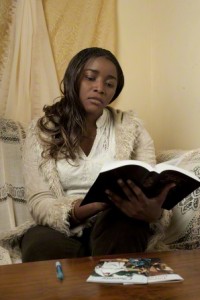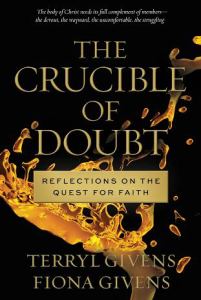This article is a continuation of the book review for The Crucible of Doubt by Terryl and Fiona Givens.
Poetic references
If you are a lover of poetry, this book is wonderful. The authors use an abundance of poetry, all of which have spiritual insight. It is unique in that it allows the reader to realize the connection that poets in the past have had with their own spiritual relationship to Heavenly Father. It is important to remember that we are all God’s children. We are all searching for truth in ways that make sense to us. Poetry is a form of literary expression, but isn’t it also a quest for truth? We can witness this from chapter to chapter in The Crucible of Doubt.
Scholarly references
 The Givens’ include a vast array of scholarly references throughout their book as well. They pay no negligence to eras, cultures, ethnicities, or religious backgrounds. This adds richness to the book by bringing to light the significance of all God’s children’s quest for truth. To the lay-reader, this may seem overwhelming. Some of the people referenced were unfamiliar to me, as I am not a historian. I would have enjoyed reading a little background on the people referenced—their time period and cultural struggles—so as to feel more connected to the significance of their words.
The Givens’ include a vast array of scholarly references throughout their book as well. They pay no negligence to eras, cultures, ethnicities, or religious backgrounds. This adds richness to the book by bringing to light the significance of all God’s children’s quest for truth. To the lay-reader, this may seem overwhelming. Some of the people referenced were unfamiliar to me, as I am not a historian. I would have enjoyed reading a little background on the people referenced—their time period and cultural struggles—so as to feel more connected to the significance of their words.
Scriptural references
The Givens’ make no apologies for the hard-hitting nature of certain scripture stories found in the Old Testament, New Testament, Book of Mormon and even throughout church history. For the lay person who may not be well acquainted with such stories, it may paint Christianity in a harsh light. But one of the most important gospel principles we learn from the restoration is the idea of “opposition in all things.” We know Christ beckoned us to follow Him—that he is the bread of life, that if we drink from his living water, we will not thirst again. But in Matthew chapter 10 verse 34 and 35 Christ said, “Think not that I am come to send peace on earth: I came not to send peace but a sword. For I am come to set a man at variance against his father, and the daughter against her mother, and the daughter in law against her mother in law.” The Givens’ give a fair balance of opposition in their scriptural references.
LDS references
The Givenses quote early church leaders throughout their work. Again, for those who are not church historians, some of the leadership referenced are not well known, and the references are not easily found in General Conference reports or the standard works of the church. This creates distance between the average reader and the authors. I, for one, am very sensitive to that distancing affect. I come from a Greek orthodox background where so many aspects of the religion were intentionally designed to separate man from God—the embellished nature of the icons, the priest’s vestments, the nature of the sacrament, to name a few. It would have been more meaningful to me if the Givens’ would have provided more background of the church history and individuals they referenced so as to draw the reader closer to their level rather than leave them at the outskirts looking in.
Mormon Cultural stereotypes
 One aspect of the book that I found foreign to my frame of reference was the several generalizations about Mormons based on someone’s un-official definition of Mormon culture, and what “many Mormons think”. I am a convert of 25 years. I learned about the church in Japan while my husband and I were living there. From the instant I began the missionary discussions I knew this was a world-wide religion. I was converted to the doctrine of the church, not the culture of the church. I had wonderful examples of Christ-like people around me in the Japanese members and the missionaries. Other than being Christian and obeying the health guidelines in the word of wisdom, the Japanese Mormons were not culturally different from their neighbors. After my husband and I returned to New Jersey, we still did not experience what the Givens’ describe as Mormon cultural flaws, (ie. people thinking they are better than everyone else). On the contrary, the Latter-day Saint community I’ve called home for 25 years has been a humble community, reaching out to others in missionary effort to share the gospel. I’ve seen dozens of youth receive calls to serve missions all over the globe, I’ve read their letters about the faithful people in Latvia, Kenya, Ireland, Germany, Russia, Hungary, the Philippines, Taiwan, Chile, Uruguay, as well as many states in the union. Never once have I heard of members acting as elitists to the non-members around them. So, for the Givens’ to imply that many Mormons think they are better than others does not hold true when we consider the world-wide nature of our church. I am then inclined to ask, who is looking through the glass darkly?
One aspect of the book that I found foreign to my frame of reference was the several generalizations about Mormons based on someone’s un-official definition of Mormon culture, and what “many Mormons think”. I am a convert of 25 years. I learned about the church in Japan while my husband and I were living there. From the instant I began the missionary discussions I knew this was a world-wide religion. I was converted to the doctrine of the church, not the culture of the church. I had wonderful examples of Christ-like people around me in the Japanese members and the missionaries. Other than being Christian and obeying the health guidelines in the word of wisdom, the Japanese Mormons were not culturally different from their neighbors. After my husband and I returned to New Jersey, we still did not experience what the Givens’ describe as Mormon cultural flaws, (ie. people thinking they are better than everyone else). On the contrary, the Latter-day Saint community I’ve called home for 25 years has been a humble community, reaching out to others in missionary effort to share the gospel. I’ve seen dozens of youth receive calls to serve missions all over the globe, I’ve read their letters about the faithful people in Latvia, Kenya, Ireland, Germany, Russia, Hungary, the Philippines, Taiwan, Chile, Uruguay, as well as many states in the union. Never once have I heard of members acting as elitists to the non-members around them. So, for the Givens’ to imply that many Mormons think they are better than others does not hold true when we consider the world-wide nature of our church. I am then inclined to ask, who is looking through the glass darkly?
References to the Atonement
Perhaps I am unique in that once I converted to the Church of Jesus Christ of Latter-day Saints, I never had any doubt of its truthfulness. I’ve struggled with gaining a testimony over certain principles, but in the end it was the Atonement of Christ that helped me through my darkest trials. I would have liked to have seen more references to the Atonement in The Crucible of Doubt. I think if there were, it could be more of a balm in Gilead rather than a bounty of intellectualism.
Finding the true key-hole
After carefully reading and re-reading many parts of this book, I can say each chapter did have pockets of wisdom that edified my soul—but they were not easy to find. I’m not sure if it was the style of writing that hindered my search or the stereotypes I needed to hurdle—but after the struggle, I found them. In a sense, each chapter was a new Mossman door. Once I put aside my expectations and concerns, it was like lifting the metal covering over the true key hole and unlocking the door to the spiritual riches that lay behind it.
Who is the intended audience?
In my opinion, this book is for those who already have a strong testimony, anchored in the Atonement, and who are looking to add intellect to the soul. It is for the cautious, who heed the words of Jacob in the Book of Mormon when he warned the people to be careful not to look beyond the mark, who can add these words to their collection of knowledge and not get lost in the scholarly rhetoric. Indeed, it can be a supplement to historical and scriptural studies for the perpetual student of the gospel. It can also be a book to help explain why others have their doubts. But for those who are struggling with their testimonies, this book may distance you further from God. For those struggling, it would be best to focus on developing a personal relationship with Heavenly Father. Ponder the words of the prophets and apostles in private prayerful moments and let the Holy Spirit confer upon you the surety of truth that can only be conveyed through the spirit of personal revelation.
About Nanette ONeal
Nanette O'Neal loves the gospel and is very happy to share her testimony on LDS Blogs. She is a convert to the church and still feels the spirit burn strong within her heart. She graduated from Mason Gross School of the Arts with a degree in music education and has taught children and adults in the private and public sphere for over twenty years. Nanette continues to study the gospel and the art of writing. She writes weekly inspirational articles on her blog and is currently working on an LDS fantasy novel series, A Doorway Back to Forever. You can find her at NanetteONeal.blogspot.com. Nanette has a wonderful husband, talented son, and three beautiful dogs.






